Winter 2024 viewing, part two: Vinegar Syndrome
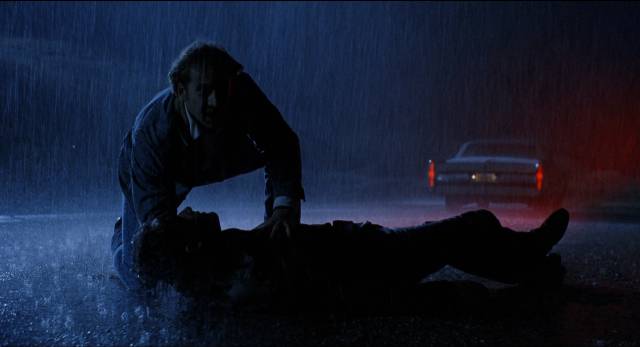
I probably should have invested some time in doing detailed calculations about the benefit of buying a Vinegar Syndrome subscription this year – after being a subscriber for a year-and-a-half, I could have figured out the ratio of worthwhile releases vs disappointments and whether I could have saved money by just buying those I really wanted. But it’s not actually that simple, because the subscription brought me a number of things I wouldn’t have bothered with but which turned out to be something I was glad to have. The biggest problem is that the subscription brings a discount on all new releases from VS sub-labels and partner companies, so every month I get sucked in to buying a stack of other movies which probably ends up more than doubling the price of the subscription itself. It’s a quandary, but I gave up thinking about it in January and ordered the subscription again for another year.
And immediately was reminded of the core issue – January’s releases included volume six of the Forgotten Gialli series, which includes only one movie I don’t already have on disk (though new transfers and new extras take a little of the sting out of that); but on top of that, the primary new release is a dual-format edition of Riccardo Freda’s The Horrible Dr. Hitchcock, which arrives just months after a perfectly fine Radiance Blu-ray, making it a less justifiable double-dip. Their February announcement was equally mixed, anchored by a dual-format edition of Saul Bass’ Phase IV, which looks like a worthwhile double-dip though it doesn’t completely supplant my 101 Films Blu-ray from 2020; there’s an alternate pre-release cut which is intriguing, but 101’s supplementary disk of Bass’ short films is absent. However, the other new releases are previously unknown to me – Piero Regnoli’s Italian Gothic The Playgirls and the Vampire (1960) and another box of Spanish gialli, including one each by Jorge Grau and Jess Franco. So my feelings about the subscription remain unresolved.
Recently, I’ve been making my way through their Black Friday releases plus a bunch from the back catalogue which I bought during the sale, and some of the January releases which arrived at the end of the month. Although there was nothing as mainstream as their puzzling edition of Michael Winner’s Death Wish II a couple of years ago, the new batch does include some higher-profile titles along with more obscure fringe productions.
eXistenZ (David Cronenberg, 1999)
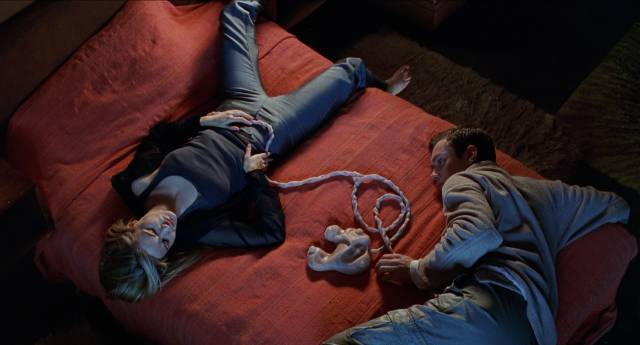
Their dual-format edition of David Cronenberg’s eXistenZ (1999) might not have caused me to reevaluate my opinion of the film, but it did give me an excuse to watch it again and there are certainly things to enjoy. My big problem with it, as with Cronenberg’s Naked Lunch (1991), is that the weird elements are never grounded in a recognizable reality, which has always been one of the filmmaker’s strengths in his best films. Given that the subject here is virtual reality and the dangers of disconnecting from the real world in order to pursue increasingly extreme experiences in a created fantasy I guess it does make sense, but that lack of grounding makes the movie feel weightless, while a lot of visual and narrative elements seem like a pastiche of Cronenberg’s earlier work. Watching it again did bring back a few personal memories as I had spent a little time in Ron Sanders’ editing room back when I was a resident at the Canadian Film Centre and saw some sequences being assembled, as well as paying a visit to the Foley stage to see the artists building the track individual sound by individual sound.
The Prophecy Trilogy (Gregory Widen/Greg Spence/Patrick Lussier, 1995-2000)
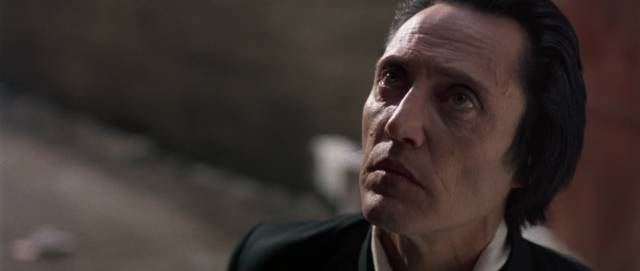
Though Biblical myths seem silly at best, they do provide material for a range of entertaining fantasy and horror movies, which I can certainly enjoy even if the underlying premises are absurd (I don’t believe in demons, but I do like a well-crafted possession movie). Gregory Widen’s The Prophecy (1995) takes a bold concept – a war in Heaven between loyal and rebellious angels – and embodies it in an effective human-scale story. Its starting point is that the entire concept of angels is monstrous – beings sent by God to do his awful bidding by delivering punishments in the human realm, foot-soldiers in the deity’s psychotic, genocidal relationship with his supposedly favoured creations. Jealous of his “love” for those the angels deem inferior, and bitter about what they are ordered to do, some of the angels would like nothing better than to see humanity exterminated. And so they bring their war to the Earthly realm, where failed-priest-turned-cop Thomas Dagget (Elias Koteas) and small-town teacher Katherine (Virginia Madsen) get caught up in the conflict when Gabriel (Christopher Walken) comes looking for a young girl (Moriah Shining Dove Snyder) who holds the key to ending it all. As events end up in a desert village, Lucifer (Viggo Mortensen) arrives to slap Gabriel down for trying to usurp his own position as god’s great adversary. It’s all nonsense, but played straight and with enough wit and style to sustain the drama to the end. It certainly helps that Widen managed to put together such a good cast – Eric Stoltz and Amanda Plummer also have vivid roles.
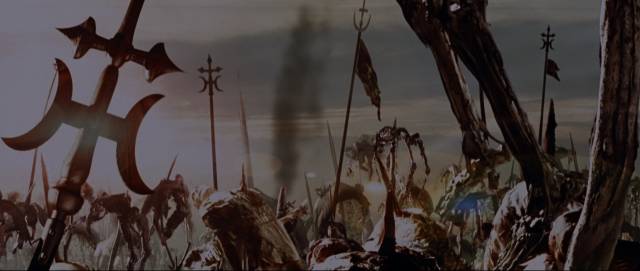
Although I liked The Prophecy when I saw it in the theatre almost thirty years ago, and subsequently a number of times on video, I don’t think I’d ever seen either of the sequels before acquiring this three-disk set. Not surprisingly, neither Greg Spence’s The Prophecy II (1998) nor Patrick Lussier’s The Prophecy 3: The Ascent (2000) can match the original – they feel like the direct-to-video knock-offs that they are. Which is not to say that they aren’t entertaining, and it definitely helps that Christopher Walken returns as Gabriel in both and actually gets something like character development. In number two, he returns to Earth to prevent the birth of a Nephilim, the child an angel sneakily impregnated unsuspecting nurse Jennifer Beals with during a one-night stand. As in the first movie, he uses a “meat puppet” to handle mundane chores – replacing Amanda Plummer with suicidal Goth Brittany Murphy. Opposing him is good guy angel Russell Wong, who believes the baby will help end the war in Heaven. The cast is rounded out with Eric Roberts as Michael and rocker Glenn Danzig as Samayel, though Koteas is absent, replaced as Dagget in a brief sequence at the start by Bruce Abbott.
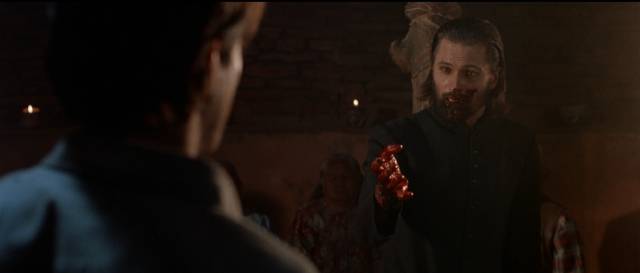
Editor Patrick Lussier made his move into directing with The Prophecy 3 and I can say he definitely went on to better things with the remake of My Bloody Valentine (2009) and my favourite Nicolas Cage movie, Drive Angry (2011). Walken is here once again, but now as a human derelict living on the streets of Los Angeles; no longer bent on human destruction, this time he’s trying to protect Jennifer Beals’ Nephilim offspring Danyael (Davino Buzzotta) against bad angel Zophael (Vincent Spano). Best supporting role goes to Brad Dourif as a fanatic who comes to assassinate Danyael. It’s obvious that producer/co-writer Joel Soisson couldn’t figure out how to extend Widen’s original concept in any interesting ways and just goes through the motions here – and yet he went on to write and direct two more sequels, though by then Walken had wisely withdrawn.
All three movies look fine in new 4K transfers in the dual-format set, with a commentary and making-of doc for each feature.
The Angel Trilogy (Robert Vincent O’Neil/Tom DeSimone, 1983-88)
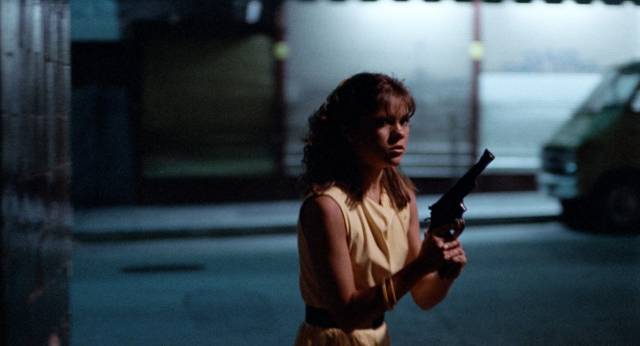
There’s nothing Biblical about the Angel trilogy released by New World in the ’80s. An odd mix of exploitation sleaze, character drama and social commentary, it’s difficult to imagine these movies being made at any other time, or with such a respectable cast – Cliff Gorman, Susan Tyrrell, Dick Shawn, Rory Calhoun, John Diehl, Elaine Giftos… In Angel (1983), Molly Stewart (Donna Wilkes) is a high-schooler in Los Angeles who conceals the fact that she’s been abandoned by her mother; a very good student, she spends her evenings cruising the strip as “Angel”, an underage hooker who earns enough to support her suburban lifestyle. The movie glosses over obvious questions about the trauma embedded in this existence and Wilkes makes the girl plucky and likeable. But the precarious balance she has established begins to fall apart when some jocks from school spot her on the street and tell everyone at school about her secret identity. Even worse, a psycho is preying on street people and Angel finds herself drawn into the investigation when her friend is killed. This turns out to have a silver lining when gruff but sensitive cop Lt. Andrews (Gorman) takes an interest in her and tries to get her off the street. Writer-director Robert Vincent O’Neil fills the movie with colourful characters – Tyrrell as Solly, Angel’s protective landlady, Shawn as flamboyant cross-dresser Mae, Calhoun as former cowboy actor turned street performer Kit Carson – and focuses more on Angel’s struggle to keep her life together than the killer sub-plot.
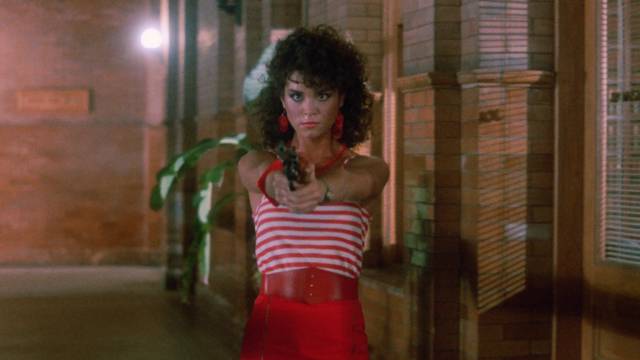
In Avenging Angel (1985), O’Neil’s follow-up, Angel (played this time by Betsy Russell) has left the streets behind thanks to Lt. Andrews (played here by Robert F. Lyons) and is in college studying law. But when Andrews is killed, she dusts off her alter-ego and heads back to the streets to track down the gang who murdered him. This reconnects her with Solly (Tyrrell) and Kit (Calhoun), while Andrews’ Captain (Ossie Davis) takes over the fatherly cop role. The loss of Wilkes and Gorman and the title character’s interesting duality make the sequel seem more generic than the original, but co-writer/director O’Neil handles the material efficiently.
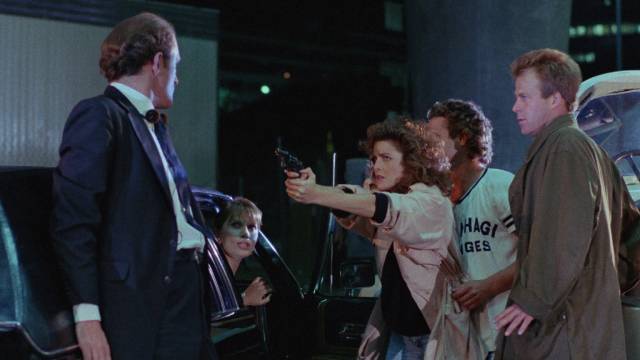
Former adult filmmaker Tom DeSimone had begun to move into more mainstream exploitation in the ’80s with movies like Hell Night (1981) and uncredited work on Danny Steinmann’s Savage Streets (1984), and had just made the over-the-top Reform School Girls (1986) when he wrote and directed the conclusion to the trilogy, Angel III: The Final Chapter (1988). Having dropped her legal career, Molly (here played by Mitzi Kapture) is now a photographer living in New York. One day, she takes a picture of someone she recognizes as the mother who long ago abandoned her. Gloria (Anna Navarro) is now a successful gallery owner with another daughter, Michelle (Tawney Fere Ellis). But her business is mixed up with criminal elements and just after the reunion she’s murdered and Michelle is drawn into the sex trafficking enterprise of Nadine (Maud Adams). Molly once again has to assume the identity of Angel to infiltrate Nadine’s outfit, bring her down and save Michelle. Trashier than the previous movies, and a far cry from the attempt at social commentary of the original, The Final Chapter is nonetheless an effective slice of ’80s exploitation, with none other than Richard Roundtree as the resident cop and a brief appearance by everyone’s favourite character actor Dick Miller.
All three movies get very good transfers and the first two disks include a number of cast and crew interviews, while the third has a director commentary.
A Gun for Jennifer (Todd Morris, 1997)
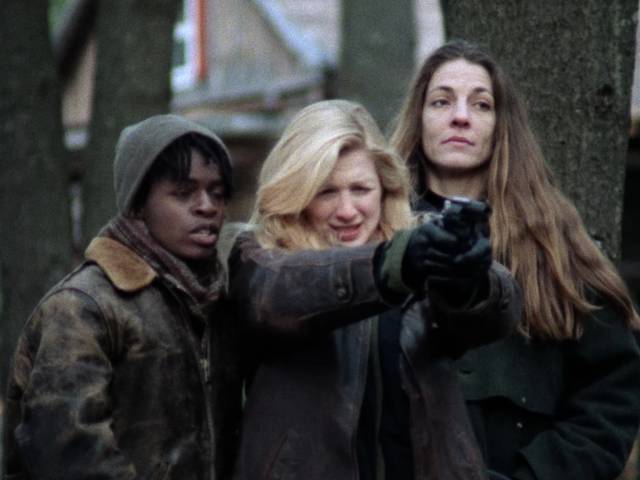
The Angel trilogy are the kind of movies explicitly referenced by A Gun for Jennifer (1997), which does a convincing job of recreating the grittier style of ’80s exploitation in an environment supposedly beyond such things. As written by former stripper and star Deborah Twiss, the script takes an explicitly feminist approach to the rape-revenge genre, offering a critique of both social attitudes towards sexual violence and the ways in which those attitudes have been encoded in popular entertainment. Twiss plays Jennifer, a woman who has left an abusive marriage in Ohio and fled to New York City. Lost in the crowded streets, she’s attacked in an alley, but before the thugs can complete the assault a group of women arrive and dispatch them. This vigilante gang take Jennifer in and initiate her into their crusade against a rape culture which too often lets men off the hook. There’s internal conflict between those who see their mission as targeting specific perpetrators and others who want to attack the power structure itself, targeting figures in authority. It gets very messy, the use of violence rebounding on the women even as it serves to expose the corruption and hypocrisy which help to perpetuate the system which has victimized these women. With taut direction by co-writer Todd Morris and well-drawn characters, including Detective Billie Perez (Benja K. Thomas), whose experience of racism and sexism within the police department makes her sympathetic to the vigilantes, A Gun for Jennifer is an excellent example of thoughtful, self-aware exploitation. The 2K transfer from the 16mm negative retains a gritty visual quality which supports the film’s air of authenticity, and the disk adds a commentary and lengthy making-of.
The Black Room (Elly Kenner, 1982)
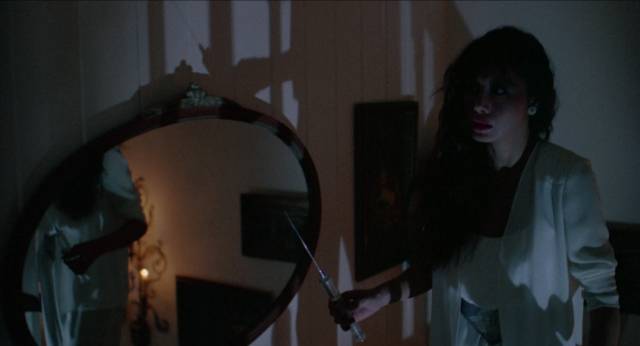
The Black Room (1982) is an odd, kinky psychological horror movie with possible supernatural overtones in which the tail end of the sexual revolution crashes headlong into a resurgent puritanism during the early stages of AIDS in the Reagan years. A businessman, bored with his middle class marriage, rents a room in a mansion up in the Hollywood Hills owned by a creepy brother and sister. The black-lined room seems as much designed for Satanic worship as for illicit sex and it feeds the businessman’s need for kinky thrills. But he doesn’t realize that the brother and sister spy on and film his antics with prostitutes. Relating his activities to his wife revitalizes their sex life until she discovers it’s real and not just fantasy; she also rents a room in the mansion, which enrages him when he finds out … an unsurprising male double standard. But what neither of them know is that the brother suffers from a rare blood disease which he self-treats by killing the prostitutes brought in by the businessman and draining their blood. The conflation of blood disease, murder and (symbolic?) vampirism is a bit queasy in retrospect, coming just a year after AIDS began to emerge. Even queasier is the admission of writer and uncredited co-director (with Elly Kenner) Norman Thaddeus Vane that much of the movie is autobiographical (the sex part, not the murder and blood-draining part). Performed and shot more like an avant garde experimental film than straight-forward exploitation, The Black Room is an interesting, unsettling time capsule presented in a fine 4K scan from the original negative, supplemented with multiple interview featurettes.
The Demon Rat (Ruben Galindo Jr, 1992)
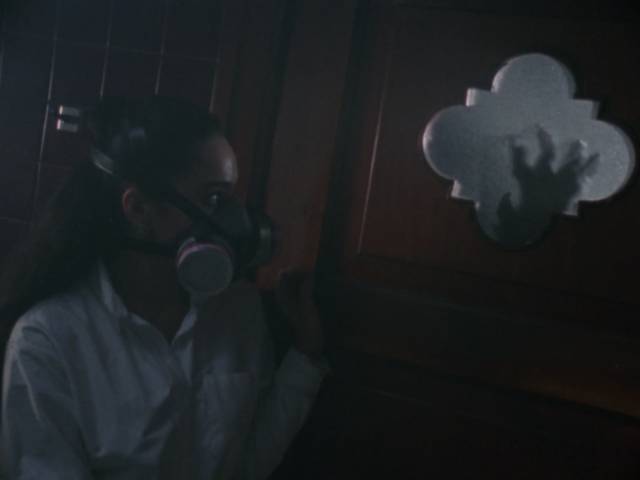
Three years after releasing a trio of Mexican horror movies from the ’80s by Ruben Galindo Jr, Vinegar Syndrome have issued another of his movies. The Demon Rat (1992) goes for apocalyptic sci-fi rather than Gothic horror, with its ambition straining an obviously limited budget. In the near-future, pollution has made the world so toxic that no one can go outside without protective clothes and a breathing mask. Teacher Irina (Rossana San Juan), going through a bitter divorce, discovers that her violent husband Roberto (Gerardo Albarran) has been dumping his company’s radioactive waste in the area, causing animal mutations. One such mutant, a man-sized rat, besieges her house (and eats her dog) and she and new friend Axel (Miguel Angel Rodriguez) have to expose Roberto while combating the increasingly aggressive monster. Reminiscent of cheap ’70s eco-horrors by people like Bert I. Gordon, The Demon Rat mixes apparent sincerity with an absurdly unconvincing creature suit, occasionally coming up with effective imagery of its toxic world. The 2K scan from original 16mm elements is predictably grainy but that seems appropriate to the material; there are three interview featurettes with Galindo and the two stars.
The Cat Creeps (Erle C. Kenton, 1946)
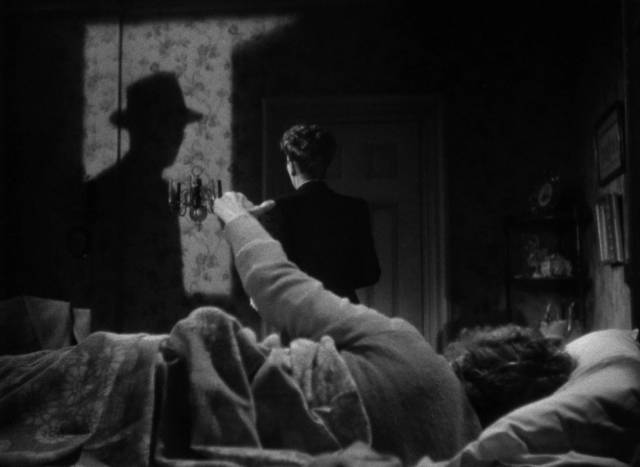
There’s nothing monstrous about the titular animal on Erle C. Kenton’s The Cat Creeps (1946), one of the last gasps of Universal’s run of horror movies which began in 1931 with Tod Browning’s Dracula and James Whales’ Frankenstein. Kenton had seen better days – his Island of Lost Souls (1932) is one of the greatest pre-Code horror movies, and even his minor monster fests The Ghost of Frankenstein (1942), House of Frankenstein (1944) and House of Dracula (1945) are enjoyable hokum. But The Cat Creeps is a throwback to earlier times, rooted in the faux horror of the old dark house movies which were inspired by the stage and screen success of The Cat and the Canary in the ’20s. There’s nothing new here and despite some visually atmospheric moments, much of the short running time is occupied with time-filling chatter and repetitive action as a group of people visit a remote island mansion to investigate a long-ago murder and rumours of a stash of stolen money. Touches of the genre’s fake supernatural elements lead nowhere, a few people are bumped off in the night and the final reveal of the killer isn’t much of a surprise. Why VS chose this as their third release on the Vinegar Syndrome Labs sub-label is a mystery – perhaps they realized they’d hit a dead end as subsequent releases in this line have been more varied and adventurous. The transfer is excellent and the disk includes a commentary from Kevin Lyons and Jonathan Rigby along with a Kim Newman interview about the use of cats in classic horror.
Black Cat/Black Cat 2 (Stephen Shin, 1991/1992)
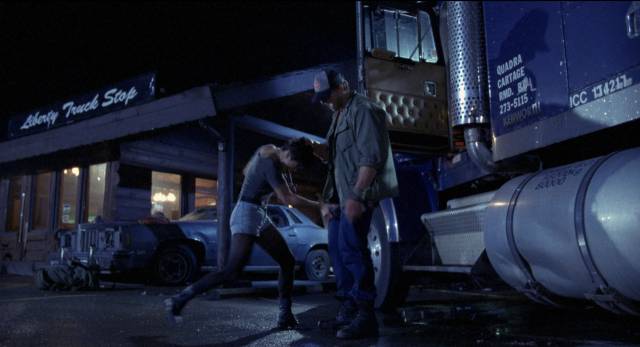
Stephen Shin’s Black Cat (1991) and Black Cat 2 (1992) have nothing to do with feline horror. These action movies were very obviously a Hong Kong riff on Luc Besson’s international hit La Femme Nikita (1990). Although we get no backstory on Jade Leung’s Erica, her immediate and violent response to sexual harassment in the roadside diner where she’s just taken a waitressing job conjures up a history of abuse. That anger and her formidable fighting skills (she takes down much larger men) draw the attention of CIA recruiter Brian (Simon Yam) and after she’s shot attempting to escape police custody and declared dead, she’s resurrected as Black Cat and put through rigorous training as an assassin. Despite her past being erased and her personality moulded into that of a killing machine (with a chip in her head to facilitate control), she becomes involved with a man named Thomas (Thomas Lam), but inevitably he discovers her secret identity and she becomes a danger to him…
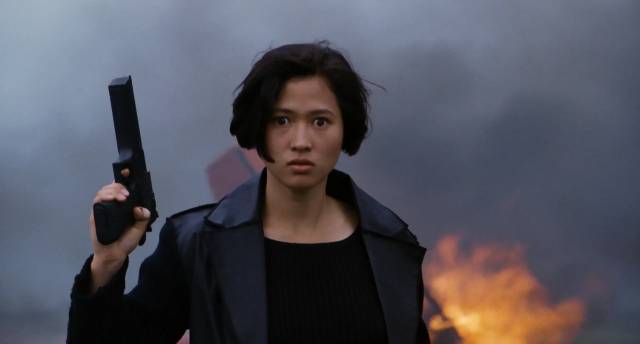
In the sequel, Erica’s personality is further stripped away as a newer, more powerful chip is implanted in her brain. In fact, she’s pretty much transformed into an automaton and the narrative focus shifts to agent Robin (Robin Shou), who’s given a remote control which can literally shut her down. Now equipped with Terminator-style abilities to detect and analyze threats, she occasionally runs amok; Robin’s distrust makes him deactivate her just as she’s about to take down the big bad guy, which suggests that the whole secret CIA program is deeply flawed. Although there are effective action sequences, the reduction of Erica to little more than a plot device in the sequel makes it less satisfying than the first movie. Both films look fine in VS’s two-disk set with the first getting a commentary track; there are also a couple of interview featurettes and a video essay by Alexandra Heller-Nicholas.
Santet/Santet 2 (Sisworo Gautama Putra, 1988/1989)
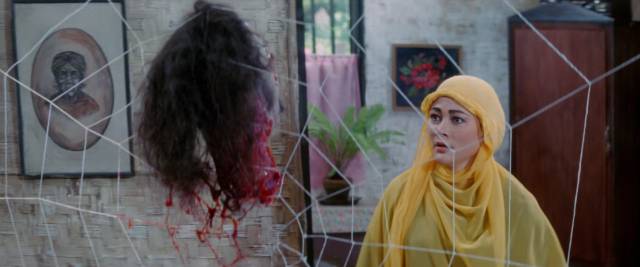
A different kind of Asian genre cinema is on display in Santet (1988) and Santet 2 (1989), a pair of supernatural horror movies from Indonesia directed by Sisworo Gautama Putra, whose Satan’s Slave (1980) was released on disk three years ago by Severin. My experience of Indonesian horror remains limited – and nothing, for me, can top H. Tjut Djalil’s Mystics of Bali (1981). There are echoes of that movie here, with shape-shifting witches, no-nonsense priests who wield their own supernatural powers against evil by channelling Allah, and an overall acceptance of the supernatural permeating everyday life. When a corrupt gangster poisons his wife and blames the local cleric, a mob brutally murders the man. The gangster tries to rape his wife Katemi (Suzzanna), but she escapes into the forest where she encounters a human-headed crocodile who turns out to be the witch Nyi Angker (Joice Erna), who takes Katemi as an apprentice. After a few unsavoury initiation rites (eating raw placenta from a fresh birth, anyone?), despite her piety Katemi uses her new powers to get revenge. But while the superstitious villagers see her as a monstrous threat (again stirred up by the gangster), the new cleric wants to redeem her.
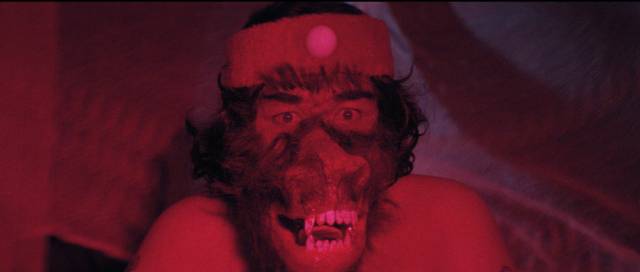
In the sequel, Katemi has settled down again in the village, though people still fear her. When the gangster’s son arrives to continue his father’s crimes, his men set fire to Katemi’s house, and she falls under the influence of Nyi Angker again; possessed by the witch she transforms into a tiger and kills her enemies. While Katemi struggles with her dilemma (at heart, she’s still a pious woman), the sequel spends interminable amounts of time on strained comedy involving a village policeman, his marital strife and efforts to get romantic with a younger widow. And I forgot to mention that both movies stop dead at one point for a lengthy musical number. Although there are a few oozy effects and wacky manifestations, neither film reaches the deranged heights of Mystics of Bali and both rely more on the appealing presence of Suzzanna, Indonesia’s biggest movie star at the time, than on the elements of horror to maintain interest. Both were scanned in 2K from original negatives, and there’s a commentary on the first movie.
Divinity (Eddie Alcazar, 2023)
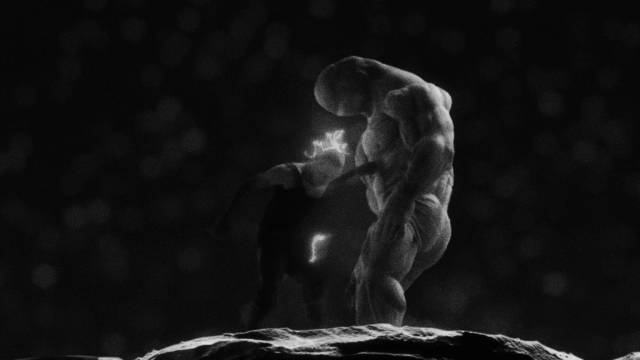
As a fan of ambitious low-budget sci-fi, I wanted to like Eddie Alcazar’s Divinity (2023) more than I did. Alcazar obviously has a way with image-making – the high-contrast black-and-white cinematography seems to give the movie an air of weight, of seriousness, an implication that it has something to say. And yet as it progresses, a feeling grows that it’s all surface, little more than aesthetic play. In taped diary entries, we receive the backstory about dying scientist Sterling Pierce (Scott Bakula) working hard In his lab to create a formula which will stop people aging and bestow immortality. He died before perfecting the formula, but one of his young sons, Jaxxon (Stephen Dorff) grows up to succeed. In the future he has brought about, the majority of women are sterile and the majority of men have descended into preening solipsism, spending their time perfecting muscle-bound bodies which they narcissistically admire. Immortality proves to be little more than vacuous hedonism.
Then a pair of brothers descend from the night sky, apparently a pair of stars manifest in human form, who have come to … what? rectify the damage wrought by Jaxxon? They enter his desert fortress, take him hostage, tie him to a chair and hook him up to an IV drip of his own undiluted formula. Nikita (Karrueche Tran), a call girl he has ordered, arrives and engages in a three-way with the silent brothers before discovering Jaxxon, who by now is mutating from the serum. A crowd arrives for Jaxxon’s birthday party, all so self-absorbed that they don’t even notice his absence. Meanwhile, a group of women in white jumpsuits exist in a kind of limbo, monitoring what’s going on. When they detect that Nikita, who has never taken the formula, is fertile and has been impregnated by the brothers, they materialize and take her back to limbo.
In the final stretch, Jaxxon is now a hulking monster and the movie erupts into an elaborate stop-motion battle between him and the two brothers while Nikita gives birth to an odd plant-like baby whose meaning was utterly unclear to me. I must admit that I enjoyed the stop-motion enormously, even though by that point I’d given up on getting any coherent point out of the movie. Narrative vagueness has seldom been allied with such precise image-making to so little ultimate effect. The disk image naturally looks pristine and is supplemented with an audio-only conversation between Alcazar and executive producer Steven Soderbergh; there’s also a video essay by Samm Deighan.
Red Rock West (John Dahl, 1993)
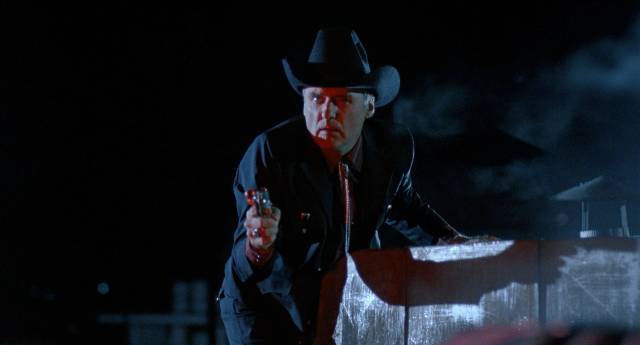
After that, it was a relief to settle back with Red Rock West (1993), the second of three neo-noir movies directed by John Dahl at the start or his career. Like the Coen Brothers’ Blood Simple (1984), this treads close to the line between homage and genre parody; this kind of play makes the film entertaining but keeps it from the air of existential dread which characterizes classic noir – it’s closer to comedy than tragedy. Former marine Michael (Nicholas Cage) arrives in Wyoming with no money, expecting an oil field job promised by an old friend, but when the foreman discovers that he has a leg injury from an explosion in Lebanon, he isn’t hired. Stopping at a seedy bar in the small town of Red Rock, his Texas license plate causes the owner to mistake him for the contract killer he has hired to knock off his wife. Michael plays along, takes the $5000 down payment, then drives out to the man’s ranch to report the contract to the wife. She pays him to knock off her husband and he writes a note to the local sheriff and heads out of town…
At which point things go very wrong and he gets caught up in an escalating tangle of events which become increasingly violent. It turns out the sheriff is the bar owner who hired him; the real hit man finally shows up and Michael becomes a target himself. He kind of falls for the wife, but naturally she’s a duplicitous femme fatale – she and her husband are not who they seem to be, their true identities rooted in a criminal past. It’s very convoluted, but Dahl keeps things moving quickly and clearly, all anchored by Cage’s restrained performance, his Nic Cage tics held in check. He’s ably supported by J.T. Walsh as the man who puts out the contract, Lara Flynn Boyle as the wife, and Dennis Hopper as Lyle from Dallas, the hit man, a fellow former marine who briefly feels empathy for the down-on-his-luck Michael before getting annoyed and trying to kill him.
Red Rock West is the first in a new line from Vinegar Syndrome called Cinématographe, with a rather vague but grandiose-sounding mission statement – “Taking its name from the Lumière Brothers invention of the same name, Cinématographe is a new sub-label from Vinegar Syndrome that seeks to fill gaps in the canon of American cinema. Offering a mix of auteur driven studio films produced during the New Hollywood era of the late 1960s and 70s all the way through the indie boom of the 1980s and 90s, Cinématographe will explore the wide breadth of American moviemaking, spanning numerous genres and scales of production.” Given the broadness of the statement, it remains to be seen whether the line will offer a consistently interesting catalogue. The second release is Ron Maxwell’s teen sex comedy Little Darlings (1980), which I have no interest in.
Comments